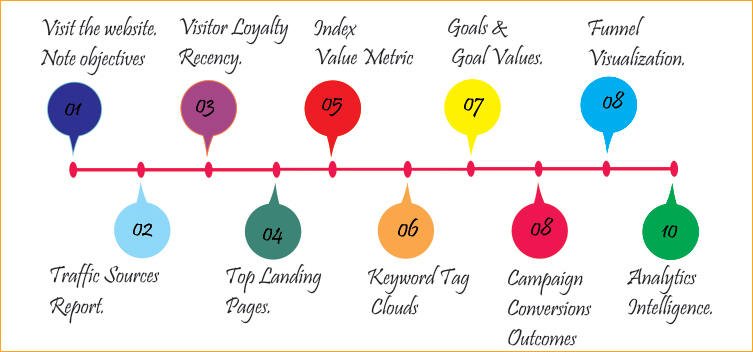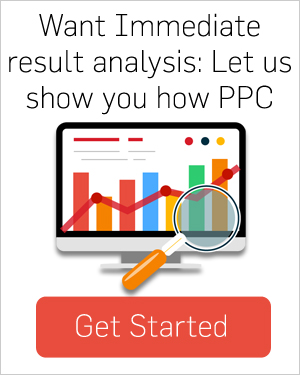

Web Analytics
Web analytics is the measurement, collection, analysis and reporting of web data for purposes of understanding and optimizing web usage.
Web analytics is not just a tool for measuring web traffic but can be used as a tool for business and market research, and to assess and improve the effectiveness of a web site. Web analytics applications can also help companies measure the results of traditional print or broadcast advertising campaigns. It helps one to estimate how changes traffic to a website after the launch of a new advertising campaign. Web analytics provides information about the number of visitors to a website and the number of page views. It helps gauge traffic and popularity trends which is useful for market research.
There are two categories of web analytics; off–site and on–site web analytics.
Off–site web analytics refers to web measurement and analysis regardless of whether you own or maintain a website. It includes the measurement of a website's potential audience (opportunity), share of voice (visibility), and buzz (comments) that is happening on the Internet as a whole.
On-site web analytics measure a visitor's behavior once on your website. This includes its drivers and conversions; for example, the degree to which different landing pages are associated with online purchases. On–site web analytics measures the performance of your website in a commercial context. This data is typically compared against key performance indicators for performance, and used to improve a web site or marketing campaign's audience response. Google Analytics is the most widely used on-site web analytics service; although new tools are emerging that provide additional layers of information, including heat maps and session replay.
Historically, web analytics has referred to on–site visitor measurement. However in recent years this has blurred, mainly because vendors are producing tools that span both categories.
The business benefits of web analytics
Tape measure representing web analytics When it comes to websites, many small business owners take the view that ‘if you build it, they will come’. But to determine success, you must find a way to measure response
To do this effectively, you need a web analytics package. It can tell you valuable information, like where your visitors are coming from, how they use your site and – to an extent – who they are.
What to measure with web analytics
To start with, don’t fall into the trap of talking about ‘hits’. This is an ambiguous label that originated in the early ‘90s when website hit counters were common. Measuring hits won’t tell you much about your website at all.
However, there are a plenty of meaningful things that you can start measuring with an analytics package.
I’ve already mentioned visitor count, which is the number of visitors your website receives. Most web analytics package will show two different visitor numbers:
Total visitors. This figure counts each visit to your site, even if the same person has returned more than once.
Unique visitors. This figure filters out repeat visits, so each person is only counted once.
Another common measurement is the number of page views. This counts how many different pages have been viewed on your website.
However, as internet technologies have evolved from page–based sites to more dynamic sites where pages can change without reloading, page views have become a less–useful measurement. Thankfully, web analytics has evolved too, introducing ‘actions’.
An action is any click that results in an interaction on the website. For instance:
- playing a video on a page
- ‘Liking’ a post on Facebook.
- placing a bid on eBay
Web referrers and searches
One of the main ways websites receive traffic is from links on other sites. These are called ‘referrers’ and their data is very valuable.
For instance, if a review gets posted about your business which links to your site, your referrers will show you that the review exists. You can also see what people did on your site after reading the review.
Even more importantly, a real–time tracking system can let you know about traffic surges as they happen, so you can respond quickly if needed.
Another source of website traffic is, of course, search engines. You’ll want to know what people are typing in to find your website, and where search engines rank your business and its competitors.
Web analytics relating to search can often be enlightening because visitors may be arriving via keywords and search engines you’re not aware of.
Analysing customer data and location
Web analytics software can show you where in the world your website traffic is coming from, so you can see if you receive a surge in traffic from a new country or region.
You can also filter interesting international traffic by referrer and search data, to understand the reason for the surge. And if you have a customer in a distant city, you can identify and tag them for present and future visits, so you know who they are.
Online marketing campaigns and goals
Often there will be a sequence of visitor actions that dictate a specific event, and this is where ‘goals’ come into play. For example, you can create a goal which will track when someone purchases an item on your website and how much they spend.
You can also track visitors who made it partly through the goal but failed to complete. This is valuable information that can help you identify problems with your online order process.
If you are expecting traffic from adverts, set up ‘campaigns’ which can track traffic specifically from your adverts. You should have a goal in mind for visitors who arrive at your site – and you can attach this goal to the campaign in order to see how well your adverts are working.
Measuring social media
Many businesses are now using social media to connect with new and existing customers. You can also use it to find out what people are saying about your company, who these people are and who might be listening to what they’re saying.
The most popular social networks include Twitter and Facebook. Conversations are endless on these sites, and web analytics tools can help you cut through the noise. For instance, Clicky – the company I work for – has a Twitter monitoring feature. You can also use a service like Klout to see the influence of people who are talking about you.
Although web analytics can seem overwhelming at first, it can reveal highly valuable data. To get the most out of your web analytics package, get into the habit of measuring web traffic daily. You’ll soon be spotting trends and coming up with ideas to improve your website&rsquos performance.
Increase Your Selling Power
Our detailed website analysis helps you identify which ad designs and page layouts are helping you increase your selling power. You can apply the valuable findings throughout your site and campaigns to get the most of your business.
Guide Your Customers
Our analytics findings enable you to understand your customer behavior so you learn to guide your customers in a successful purchase direction.
Track Traffic and Competitive Keywords
With Traffic's online stats service, you can learn which search engines are sending you most of the traffic and which keywords the visitors are using to search your products and services.
Increase Conversions and Sales
With greater knowledge about market needs and trends, you can make crucial business decisions that can lead you to increased conversions and sales.
Identify Exit Pages
Our comprehensive website analysis enables you to identify the web pages from which the most visitors are exiting your site. This can help you locate the problematic areas on your site and correct the errors in time.
Track Business 24/7
Using our analytics service you can keep complete and round–the–clock track of your business including marketing campaigns, customer growth, and even customer loyalty determined by the frequency of visits
Identify Profitable Markets
Our comprehensive reporting provides you with full knowledge about your potential target markets and you can easily point out the cities drawing your sales volume. The exact time of visits and conversions is also kept in record for further advantage.
Know Customer Behavior
The analytics service helps you understand the needs, choices and preferences of your customers in an improved way. By this you can know what a certain clientele thinks of your business and what you should do to improve it
Address Target Market More Effectively
As you know your customers better, you are able to address to the needs of different clients differently and make your e–marketing initiatives more effective accordingly.
Identify Current Market Demands
The findings of analytics services reveal the latest industry trends and current market demands. Once you know what the customer is actually looking for at a certain point of time, you are able to make additions and subtractions to your business offerings accordingly.
Categorize Customers by Choice vs. Affordability
A comprehensive website analysis helps you find out whether your customers are brand conscious or price conscious. This knowledge enables you to make changes to your product and service offerings to meet the needs


